From its bold F-O-R-D grille to its strong shoulder line, Ford Ranger Raptor is every inch Built Ford Tough while also incorporating an aerodynamic design that helps reduce drag and improve performance and efficiency.
“Big ticket items like the fresh-face attention grabbing design and our new 3.0L twin-turbo V6 are very obvious enhancements in performance on Ranger Raptor, but it’s the time we spend on getting the details right that really make the difference for our customers,” said David Grice, chief platform engineer, Ranger, and Everest.
To sculpt the truck’s shape, Ranger Raptor underwent around 700 hours of virtual and physical aerodynamics testing with cutting-edge computational fluid dynamics able to test the effect of design changes almost instantly.
Designers and engineers also looked to an unlikely source for inspiration to manage airflow around the wheels – a major source of aerodynamic drag. The Ford Mustang shares little in common with the Ranger Raptor, but the Australian development team was influenced by techniques used by their U.S. counterparts to help manage efficient airflow around the wheels and wheel arches of the Mustang.
The importance of aerodynamics on truck design
Aerodynamics has not always played an important part in the design of the Ranger Raptor or wider Ranger family. As more and more customers choose pickups for work, family and play, designers have had to improve pickup design to match customer expectations on efficiency and refinement.
The basic pickup shape is not the easiest to work with when it comes to refining aerodynamic efficiency, according to Dr. Neil Lewington, technical specialist and aerodynamics supervisor, Ford Australia. With large frontal areas, big open wheel spaces, a dual cab design that ends suddenly and an open load box, designers have a lot to overcome when designing a new pickup.
“Small changes in design can make a huge difference in aerodynamic efficiency,” said Doc. Lewington.
“With new Ranger Raptor, we focused our attention on several key areas: creating air curtains around the front and rear wheels to reduce aerodynamic drag, tuning the C-pillar treatment to improve airflow above the load box, and shaped the box capping and tailgate spoiler to minimise drag from the wake.”
Managing airflow around the wheels and box step
The wheels on your vehicle are a major source of aerodynamic drag. And while you could drape the wheels in physical curtains to get the air to flow around it would look dinky, according to Dr Lewington. So, Ranger Raptor’s designers and engineers, taking inspiration from the air curtains used on Mustang, worked together to develop a clever way of shaping the vehicle’s fog lights to create front wheel aero curtains.
The front bumper and fog lamp bezel were shaped to channel air flow around the front wheels which, according to Dr. Lewington, does two things. “It helps to relieve some of the high pressure on the front of the vehicle which reduces aerodynamic drag and also mixes this higher momentum air flow with the front wheel wake to reduce drag caused by the wheels.”
“Managing the air flow around the wheels is critical to improving aerodynamic efficiency, whether the vehicle is designed for performance, urban or utility usage. On Ranger, in addition to air curtains, we developed tyre spoilers ahead of the rear wheels to effectively reduce the bluffness of the rear tyres and minimise the potential of the airflow to impact on the rear suspension and the box step,” said Dr. Lewington.
The ingenious rear box step makes it easier than ever to access the load box; no more clambering onto a rear wheel and swinging yourself into the back of the truck. While the team ensured it had minimal impact on aerodynamic drag, Dr. Lewington said the focus was always on improved customer experience.
“The box step sits partially in the wake of the rear tyre, so is relatively insensitive, which is a win-win; minimal aerodynamic impact and an improved customer experience,” concluded Dr. Lewington.
Streamlining the load box
Ensuring the load box is aerodynamic as possible, Dr. Lewington said the team worked on the shape of the C-pillar, box capping and tailgate spoiler to improve airflow characteristics above and around the load box.
“Managing the flow of air above the load box has an impact on vehicle aerodynamics. The pickup shape dictates that you have a large recirculating flow in the cavity above the tray,” said Dr. Lewington.
“By carefully tuning the roof and C-pillar geometry to interact with the box capping and tailgate spoiler shape, we were able to manipulate the extent of the recirculation and the shape of the wake behind the truck and reduce aerodynamic drag.”
Despite its bold front end and wide wheel arches, the overall drag force of the new Ranger Raptor has been slashed by an impressive 3 percent. While this improves road holding and helps to reduce wind noise in the cabin it also improves efficiency; a three percent reduction in drag at highway speeds equates to a one percent improvement in fuel efficiency.
Ford Ranger Raptor
With its thumping 3.0L twin-turbo V6 engine making 292kW and 583Nm of torque, 10-speed automatic transmission, selectable drive modes, including Baja, the new Ford Ranger Raptor is the most potent version yet.
In addition to its state-of-the-art connectivity systems, Ranger Raptor boasts front and rear differential locks, FOX shocks with Live Valve technology, advanced driver-assist systems, active valve exhaust and more.

